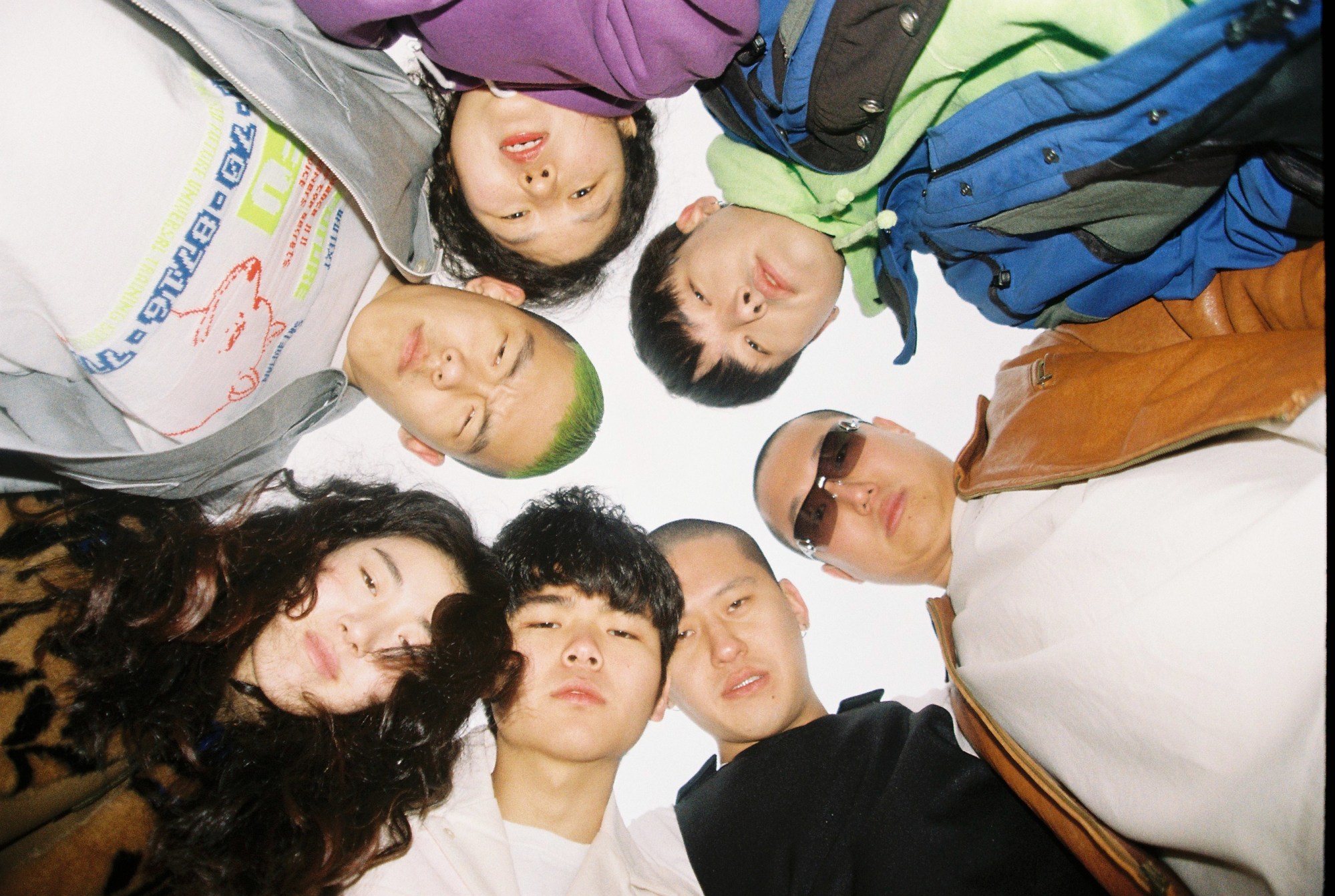Within the first few seconds of music collective Balming Tiger’s “Kolo Kolo,” green-haired rapper Omega Sapien switches from rapping in English to Spanish and back to English again. The languages blur together so seamlessly over the skittish percussion that it’s hard to tell whether you understand everything, or none of it at all. That ambiguity continues as one of the many faces of the music collective is shown training among a group of men for a sporting event: sped-up monkey bar squats and hallway sprints, the air thick with masculinity and brotherhood. Then, the music takes a turn towards ambient jazz, with a final shot of Omega Sapien crashing into oncoming waves as everything fades to black. If it sounds like a lot, that’s because it is.
Balming Tiger pulled their name from the popular Tiger Balm, a centuries-old ointment that has become not only a pain-relieving staple in households across the globe but a symbol of Asia’s global influence. It’s this wide-spread, cross-cultural impact that Balming Tiger wanted to tap into when they formed the collective in 2018. The Seoul-based group currently consists of nine members: Omega Sapien, Sogumm, Unsinkable, wnjn, Mudd the Student, San Yawn, Abyss, Henson Hwang, and Jan’Qui. Charged raps blend with sultry vocals resulting in an eclectic mix of energy-raising and reflective beats.
In the past year, the group has grown an equally diverse fanbase, ranging from K-pop idols to teens across Europe and the States. Part of that is due to the recent #hakunamatatachallenge, which was started by dance studio Only ForwarD as a way to fundraise for their COVID-19 Emergency Fund. Whether anyone knows the meaning of the words playing in the background while they dance seems to be irrelevant. There’s a shared excitement not only for the collective good being done — each post created translates to 5,000 won (roughly £3.50) donated — but for the permission to let loose, as the energetic track openly calls for.
Their 2019 track “Armadillo,” a playfully chopped and screwed tune boosted by swinging camera shots, earned them Music Video of the Year at the 2020 Korean Hip-Hop Awards. Last month, Vans released an exclusive BT-illustrated sneaker, just weeks after it was announced that “Kolo Kolo” was nominated by the Berlin Music Video Awards for its hypnotic visuals too. They were set to play a slew of festivals around the world before the pandemic took hold
If the timing of the viral challenge suggests anything, it’s that Balming Tiger is here to stay on our radar. We caught up with the group to learn more about lifting inspiration from a studio session gone wrong and what they’re working on next.

Several K-pop stars have recently shown “Kolo Kolo” love with the #hakunamatatachallenge, first Hyun Ah and Dawn, then a week later Sandara Park. What inspired the now-viral track?
“Kolo Kolo” is a Korean onomatopoeia word that literally means “to cough up”. When we were working on the song in 2019, our producer, Unsinkable, wasn’t feeling well and couldn’t stop coughing. San had a hard time mixing the beat over it, so eventually he said to him ‘Why don’t we just keep your coughing in this song and name it “Kolo Kolo”?’ and the rest was history. The track was completed long before coronavirus spread around the world but, in a twist of events, it’s now being used to do good.
Another thing that stands out about “Kolo Kolo” is the constant swapping of different languages. How did that come about?
Omega Sapien, who wrote the lyrics, is a third culture kid who has lived in Korea, China, the United States, and Japan. We think that his first couple of bars reflect the type of stateless art that we pursue.
It definitely feels unbound by any construct — be they state lines or genre. What does the group think about the global expansion of K-pop?
K-pop is more of a cultural phenomenon than a music genre; there are so many musical genres and various subcultures within the K-pop category. Many fusion and alternative groups are emerging in Korea, like those who want to merge BTS’s heart with Aphex Twin’s head.
One of the characteristics of Koreans and K-pop is that both quickly accept and digest new things. And it’s this sensitivity to trends that has led numerous young artists to incorporate the new into the old, hence bringing out different forms, concepts, music or art that never existed before. We grew up with Flying Lotus and Girls’ Generation. Now, with the global demand for K-pop, we’ve been given an opportunity to reach people around the world with music birthed from our own hybrid experiences.
How would Balming Tiger classify its discography?
We’d like to be seen as a “multi-national alternative K-pop band,” which is challenging in terms of what genre that actually is, but that’s intentional. Our members don’t want to be limited or defined by one specific genre. As all people do, we’re constantly changing what we want to consume, hear, and produce based on what we’re living at the moment. And what it comes down to is us wanting to make music that we can play in front of others without regret. Music that ties us together and quenches our thirst.

You must be pretty pleased with the success of “Armadillo”!
It’s always a great honour to be recognised and awarded. We think it reflects that there is love for us and, at the same time, that we do inspire people. We created Balming Tiger as a platform to introduce young and independent artists who weren’t getting recognised to the world market. For artists or groups like us, we need that genuine understanding, feedback, and support to thrive. Luckily, we have people’s attention now and their support will be our greatest strength when we progress forward.
Let’s talk about the support coming from brands, notably Vans. How did that collaboration come about?
We’ve had a good relationship with Vans since our early days. We initially collaborated with them on the production of “Icy”. Then in 2019, we performed at the House of Vans party and were asked to judge their annual ‘Musicians Wanted’ competition. They seem to think that our young and creative identity goes well with their brand mission. For the sneakers, each of our members took turns drawing animals and objects that best represented themselves. The mix — a frog, SP404, and a mother figure, to name a few — came from a list of abstract feelings that we wanted to communicate: ambition, sexual desire, energy, peace, and love.
There’s this constant exchange between illustration and music, from the Vans collaboration to your own comic series. Can you tell us more about the latter?
We release a comic for each song, which might be one of the most significant differences between our group and others. We think they’re the best way to express human fantasy. And doesn’t everyone love cute, funny stories? We wanted to make sure that element was incorporated into all of our art.
It seems like the best bet is to expect the unexpected, but what’s next for Balming Tiger?
We’ll continue to explore new and non-existent art and fun ways to deliver it to people. This year, some members will release solo projects, with Omega Sapien first. Dropping in May, his EP is both a personal story but also an attempt to capture all the ideals we’ve mentioned earlier. As an Asian, as a third culture kid raised in various countries, as a person in his 20s, as a K-Pop artist, as a human being living in the 21st century, as being a part of nature, he tried to capture every point of view. Mudd the Student, our newest member, will release his album in June shortly after. This all leads up to a compilation album, which we’ll debut towards the end of 2020. For the album, we wanted to create a sound that has never existed, a piece of original music that will be difficult to define.


